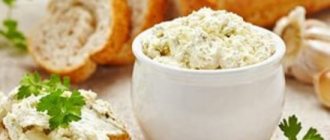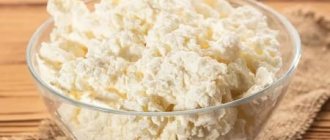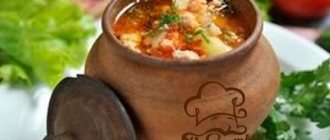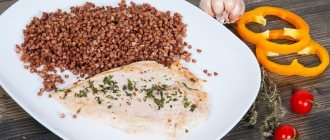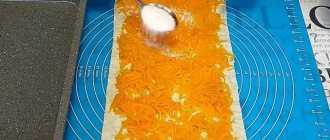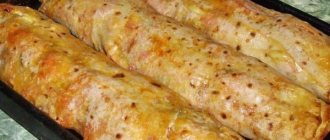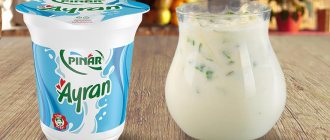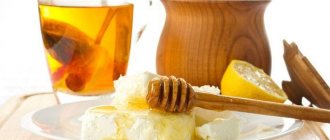Quote from MargaritaRita70
Read in full In your quotation book or community!
Several best recipes using cottage cheese with herbs and garlic
Classic cottage cheese dishes - sweet, with sugar, jam, dried apricots and raisins. However, the options for using the product are not limited to them. Salty, spicy snacks and fillings are also prepared from high-quality, most often homemade, cottage cheese.
To obtain a paste-like mass, mayonnaise of varying degrees of fat content is used. It is this that, among other things, smoothes out the sharpness of garlic juice, and if the sauce includes mustard or its oil, then the dishes acquire a completely indescribable flavor.
Cottage cheese with herbs and garlic - general principles of preparation
• Cottage cheese with herbs and garlic – a homogeneous, slightly spicy curd mass. To bring its main components to the required, uniform state, you may need a blender (immersion or with a bowl). In the absence of this kitchen processor, you can take the most ordinary meat grinder with a very fine grid or a rare metal sieve.
• In most cases, such a dish is not subjected to any heat treatment, an exception may be the use of curd mass to fill pies fried in a frying pan. Therefore, all products for cooking should be taken only when fresh.
• Cottage cheese is the basis of such a dish. Its consistency, graininess and fat content do not play a special role. Everyone can choose the one they prefer. But it should be noted that the fattier the cottage cheese, the easier it is to stir and the easier it will be to spread the mixture on bread or vegetables. Therefore, sour cream or mayonnaise is added to low-fat, and low-fat for a dietary dish is blended with a blender.
• You can add any greens - dill, parsley, cilantro, mint, basil, etc. It all depends on the type of dish being prepared and personal preferences. It is not advisable to add green onions - the dish may taste bitter.
• The homogeneous curd mass is adjusted to the desired taste by adding salt and seasoning with black pepper.
• Cottage cheese with herbs and garlic can also be served as an independent dish. This mass is spread on slices of bread, crispbread, fresh or fried vegetables (zucchini). With it you can make Turkish unleavened pies from thin pita bread. It is also perfect for stuffing fresh vegetables (tomatoes) or filling holiday profiteroles. It’s very simple and quite easy to prepare a festive appetizer roll with tomato pieces inside.
Recipe Cottage cheese with pickled cucumber and dill. Calorie, chemical composition and nutritional value.
Nutritional value and chemical composition of “Cottage cheese with pickled cucumber and dill.”
The table shows the nutritional content (calories, proteins, fats, carbohydrates, vitamins and minerals) per 100 grams of edible portion.
| Nutrient | Quantity | Norm** | % of the norm in 100 g | % of the norm in 100 kcal | 100% normal |
| Calorie content | 72 kcal | 1684 kcal | 4.3% | 6% | 2339 g |
| Squirrels | 9.7 g | 76 g | 12.8% | 17.8% | 784 g |
| Fats | 2.2 g | 56 g | 3.9% | 5.4% | 2545 g |
| Carbohydrates | 2.6 g | 219 g | 1.2% | 1.7% | 8423 g |
| Organic acids | 0.9 g | ~ | |||
| Alimentary fiber | 0.6 g | 20 g | 3% | 4.2% | 3333 g |
| Water | 81.4 g | 2273 g | 3.6% | 5% | 2792 g |
| Ash | 2.621 g | ~ | |||
| Vitamins | |||||
| Vitamin A, RE | 68.6 mcg | 900 mcg | 7.6% | 10.6% | 1312 g |
| Retinol | 0.013 mg | ~ | |||
| beta carotene | 0.335 mg | 5 mg | 6.7% | 9.3% | 1493 g |
| Vitamin B1, thiamine | 0.029 mg | 1.5 mg | 1.9% | 2.6% | 5172 g |
| Vitamin B2, riboflavin | 0.129 mg | 1.8 mg | 7.2% | 10% | 1395 g |
| Vitamin B4, choline | 19.52 mg | 500 mg | 3.9% | 5.4% | 2561 g |
| Vitamin B5, pantothenic | 0.108 mg | 5 mg | 2.2% | 3.1% | 4630 g |
| Vitamin B6, pyridoxine | 0.093 mg | 2 mg | 4.7% | 6.5% | 2151 g |
| Vitamin B9, folates | 19.175 mcg | 400 mcg | 4.8% | 6.7% | 2086 g |
| Vitamin B12, cobalamin | 0.571 mcg | 3 mcg | 19% | 26.4% | 525 g |
| Vitamin C, ascorbic acid | 7.89 mg | 90 mg | 8.8% | 12.2% | 1141 g |
| Vitamin D, calciferol | 0.013 mcg | 10 mcg | 0.1% | 0.1% | 76923 g |
| Vitamin E, alpha tocopherol, TE | 0.211 mg | 15 mg | 1.4% | 1.9% | 7109 g |
| Vitamin H, biotin | 3.316 mcg | 50 mcg | 6.6% | 9.2% | 1508 g |
| Vitamin K, phylloquinone | 4.3 mcg | 120 mcg | 3.6% | 5% | 2791 g |
| Vitamin RR, NE | 1.8799 mg | 20 mg | 9.4% | 13.1% | 1064 g |
| Niacin | 0.26 mg | ~ | |||
| Macronutrients | |||||
| Potassium, K | 141.85 mg | 2500 mg | 5.7% | 7.9% | 1762 |
| Calcium, Ca | 97.83 mg | 1000 mg | 9.8% | 13.6% | 1022 g |
| Silicon, Si | 0.111 mg | 30 mg | 0.4% | 0.6% | 27027 g |
| Magnesium, Mg | 21.76 mg | 400 mg | 5.4% | 7.5% | 1838 |
| Sodium, Na | 574.19 mg | 1300 mg | 44.2% | 61.4% | 226 g |
| Sera, S | 93.26 mg | 1000 mg | 9.3% | 12.9% | 1072 g |
| Phosphorus, P | 113.6 mg | 800 mg | 14.2% | 19.7% | 704 g |
| Chlorine, Cl | 53.19 mg | 2300 mg | 2.3% | 3.2% | 4324 g |
| Microelements | |||||
| Aluminium, Al | 28.6 mcg | ~ | |||
| Bor, B | 0.4 mcg | ~ | |||
| Vanadium, V | 0.61 mcg | ~ | |||
| Iron, Fe | 0.583 mg | 18 mg | 3.2% | 4.4% | 3087 g |
| Yod, I | 4.05 mcg | 150 mcg | 2.7% | 3.8% | 3704 g |
| Cobalt, Co | 1.1 mcg | 10 mcg | 11% | 15.3% | 909 g |
| Lithium, Li | 0.138 mcg | ~ | |||
| Manganese, Mn | 0.0908 mg | 2 mg | 4.5% | 6.3% | 2203 g |
| Copper, Cu | 36.05 mcg | 1000 mcg | 3.6% | 5% | 2774 g |
| Molybdenum, Mo | 3.456 mcg | 70 mcg | 4.9% | 6.8% | 2025 |
| Nickel, Ni | 0.394 mcg | ~ | |||
| Tin, Sn | 5.63 mcg | ~ | |||
| Rubidium, Rb | 0.7 mcg | ~ | |||
| Selenium, Se | 13.168 mcg | 55 mcg | 23.9% | 33.2% | 418 g |
| Strontium, Sr | 12.88 mcg | ~ | |||
| Fluorine, F | 15.08 mcg | 4000 mcg | 0.4% | 0.6% | 26525 g |
| Chromium, Cr | 2.27 mcg | 50 mcg | 4.5% | 6.3% | 2203 g |
| Zinc, Zn | 0.2204 mg | 12 mg | 1.8% | 2.5% | 5445 g |
| Digestible carbohydrates | |||||
| Starch and dextrins | 0.057 g | ~ | |||
| Mono- and disaccharides (sugars) | 2.5 g | max 100 g | |||
| Sterols (sterols) | |||||
| Cholesterol | 6.49 mg | max 300 mg | |||
| Saturated fatty acids | |||||
| Saturated fatty acids | 1.3 g | max 18.7 g | |||
| Monounsaturated fatty acids | 0.634 g | min 16.8 g | 3.8% | 5.3% | |
| Polyunsaturated fatty acids | 0.123 g | from 11.2 to 20.6 g | 1.1% | 1.5% | |
| Omega-6 fatty acids | 0.1 g | from 4.7 to 16.8 g | 2.1% | 2.9% |
The energy value of Cottage cheese with pickled cucumber and dill is 72 kcal.
Primary Source: Created in the application by the user. Read more.
** This table shows the average levels of vitamins and minerals for an adult. If you want to know the norms taking into account your gender, age and other factors, then use the “My Healthy Diet” application.
Curd snack with herbs: ingredients
To prepare the dish you will need:
- 400 grams of cottage cheese.
Any will do, not necessarily fresh. With a low-fat version, the snack will be dietary, but it is more difficult to stir; with a fatty version, it will be more expensive, easier and tastier, since fat is a flavor enhancer. My version today is 0% cottage cheese.
- Greenery.
You can add everything except green onions (they make the dish bitter). I have cilantro, parsley, green basil, dill. The good thing is that in a blender you can even grind stems, withered, stale greens - everything that is usually thrown away. Adding a couple of mint leaves would go very well with the theme – just not more!
- Garlic – 2 large cloves.
It all depends on your taste, you can add more, or you can leave it out at all.
- Lemon – 1 slice.
Lemon goes well with mint, but the snack turns out quite tasty without it.
- Optional ingredients.
If the cottage cheese does not mix well in the blender, does not break up, or is too viscous, you can add to it: tomato, bell pepper, cucumber. If it’s not the season - a little mayonnaise (1 tsp) or even vegetable oil - then our cottage cheese snack on a sandwich will spread better and be easier to mix.
Cottage cheese with cucumber and herbs for weight loss
| INGREDIENTS | QUANTITY |
| Bell pepper | 0.1 kg |
| cucumber | 150 g |
| parsley | 30 g |
| 0-2% cottage cheese | 0.2 kg |
| pepper mixture | 5 g |
| garlic | 2 pieces |
How much time - 35 minutes.
What is the calorie content - 82 calories.
How to cook:
- Rinse the cucumber and, if necessary, peel it, be sure to cut off the ends.
- Grate the fruit on a coarse grater and place in a sieve or colander to drain excess liquid.
- Wash the sweet peppers and remove internal seeds and membranes.
- Cut the soft part of the vegetable into thin and short strips.
- Press the garlic through a crush.
- Rub the cottage cheese through a sieve or grind with a blender to get real cream.
- Add a mixture of peppers and garlic to it and combine.
- Let the mixture sit for about 15-20 minutes in the refrigerator. To do this, it is better to cover the container with film so that it does not absorb other odors.
- Wash the parsley and chop it using a sharp knife.
- Mix with cucumber and sweet pepper.
- Next, combine the vegetable mass with the one in the refrigerator - and you’re done.
Potato roll with cottage cheese
Ingredients:
- butter – 75 g
- nutmeg – 1 pinch
- salt - to taste
- bacon – 200 g
- grated parmesan – 100 g
- flour – 200 g
- medium-sized bulbs - 1 pc.
- yolk – 1 pc.
- egg – 1 pc.
- medium potatoes – 500 g
- cottage cheese – 100 g
- vegetable oil – 1 tbsp. l.
- fresh spinach – 1 kg
- baking powder – 1 tsp.
Preparation:
- Wash the potatoes and boil in their skins until tender, 20 minutes. Peel and chop the onion. Wash the spinach and cut off the stems. Place the leaves in a dry saucepan and place on low heat. As soon as the leaves wilt, remove from the heat and squeeze out as much moisture as possible.
- Peel the potatoes and rub through a sieve. Add almost all the flour, baking powder, 1 egg, a little salt. Knead into a homogeneous dough.
- Heat vegetable oil in a saucepan, fry the onion for 4 minutes. Add spinach and cook, stirring, 2 minutes. Transfer the spinach and onions to a bowl and let cool slightly. Add cottage cheese, half the Parmesan, yolk, nutmeg, salt and pepper. To stir thoroughly.
- Roll out the potato dough on a floured surface into a 35x25cm rectangle. Cover with strips of bacon. Spread the spinach filling over the dough, leaving about 1.5 cm around the edges.
- Roll up, wrap tightly in a linen napkin and tie the ends with twine. Place the roll in a wide pan of boiling salted water and cook for 30 minutes.
- Remove the roll from the pan, unwrap it and let cool. Cut into 1.5 cm wide pieces. Place in a short baking dish, drizzle with melted butter and sprinkle with remaining Parmesan. Place in an oven preheated to 200°C for 15 minutes. Serve immediately.
Types and calorie content of cottage cheese
It is absolutely impossible to talk about how many calories are in cottage cheese in isolation from the type of fermented milk product. The varieties, in turn, completely depend on the fat content - that very “percentage” indicated on the packaging. It means how many grams of animal fat are contained in 100 grams of the finished product. Accordingly, the fatter it is, the higher the calorie content.
According to this parameter, cottage cheese is divided into the following varieties.
Low fat
This is not a separate variety, but a whole group, which includes cottage cheese with a fat content of up to 1.8%. For convenience, we will immediately indicate its nutritional value. The calorie content per 100 g of product is indicated, as in the case of fat content in cottage cheese:
- 0% – 71 kcal,
- 1% – 79 kcal,
It is worth understanding that calorie content depends not only on the fat content, but also on the raw materials used and the protein it contains. In this case, the raw material is low-fat milk.
Low-fat cottage cheese is very well absorbed by the body, so it is recommended for dietary nutrition. For example, cheesecakes or casseroles are prepared from it, which are so loved by visitors to gyms and fitness clubs. They taste practically no different from dishes made from fattier varieties, but with a strict calculation of BJU, the calorie content of 1% cottage cheese looks much more attractive.
Low-fat
The next group is very arbitrary, since it is very rarely found on sale, but is limited to a fat content of 2-4%. This cottage cheese is more filling and, due to the increased percentage of protein in the composition, more nutritious. In principle, it can even be recommended to those who watch their figure, but do not adhere to an extremely strict diet. At the same time, dishes from it can be prepared approximately the same.
Most often you can find 2% cottage cheese in stores. Its nutritional value is 103 kcal.
Light (classic)
Classic is usually called a composition with 5% fat content. It is consumed as an independent dish and is actively used in cooking, supplemented with vegetables, herbs, berries or sweet fruits. It is used for making casseroles, and also as a filling for pies, pancakes or snacks.
Calorie content of 5% cottage cheese – 121 kcal.
Bold
This is the name of a product with a fat content of 9%. Despite almost twice the nutritional value, its uses are approximately the same: filling for pancakes, casseroles, puddings, cheesecakes, cheesecakes.
The calorie content of 9% cottage cheese is expected to be higher - 159 kcal.
Fatty
Looking at the fat content of semi-fat cottage cheese, it is easy to guess that the animal fat in this variety is 18%. And indeed it is. Its structure is very thick, sticky, so it makes good pancakes, Easter cakes, flourless casseroles, cheesecakes, cakes, buns and other baked goods.
The nutritional value of 100 g of product is impressive - as much as 232 kcal - approximately 10% of the total daily calorie intake for an adult.
Cottage cheese snack with herbs: step-by-step photo recipe
To prepare, we need a blender, a food processor, or at least a meat grinder or mixer to grind the cottage cheese well.
1. Cut the garlic into 4 parts and throw it into a blender.
2. We also send washed, dried and coarsely chopped greens there.
3. Salt (the mixture will grind better with salt) and chop as finely as possible.
4. Add half the cottage cheese and stir.
5. If necessary, add salt, add the juice of one lemon slice (if you want), add the rest of the cottage cheese and mix thoroughly again.
Congratulations, the cottage cheese and herbs appetizer is ready!
